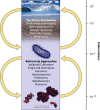Central role of the cell in microbial ecology
- PMID: 19946138
- PMCID: PMC2786577
- DOI: 10.1128/MMBR.00027-09
Central role of the cell in microbial ecology
Abstract
Over the last few decades, advances in cultivation-independent methods have significantly contributed to our understanding of microbial diversity and community composition in the environment. At the same time, cultivation-dependent methods have thrived, and the growing number of organisms obtained thereby have allowed for detailed studies of their physiology and genetics. Still, most microorganisms are recalcitrant to cultivation. This review not only conveys current knowledge about different isolation and cultivation strategies but also discusses what implications can be drawn from pure culture work for studies in microbial ecology. Specifically, in the light of single-cell individuality and genome heterogeneity, it becomes important to evaluate population-wide measurements carefully. An overview of various approaches in microbial ecology is given, and the cell as a central unit for understanding processes on a community level is discussed.
Figures




Similar articles
-
Microbial cultivation and the role of microbial resource centers in the omics era.Appl Microbiol Biotechnol. 2013 Jan;97(1):51-62. doi: 10.1007/s00253-012-4533-y. Epub 2012 Nov 9. Appl Microbiol Biotechnol. 2013. PMID: 23138712 Review.
-
Linking bacterial identities and ecosystem processes: can 'omic' analyses be more than the sum of their parts?FEMS Microbiol Ecol. 2011 Jan;75(1):2-16. doi: 10.1111/j.1574-6941.2010.00938.x. FEMS Microbiol Ecol. 2011. PMID: 20662931 Review.
-
Cultivating the uncultivated: a community genomics perspective.Trends Microbiol. 2005 Sep;13(9):411-5. doi: 10.1016/j.tim.2005.07.003. Trends Microbiol. 2005. PMID: 16043355 Review.
-
Progress in cultivation-independent phyllosphere microbiology.FEMS Microbiol Ecol. 2014 Jan;87(1):2-17. doi: 10.1111/1574-6941.12198. Epub 2013 Sep 30. FEMS Microbiol Ecol. 2014. PMID: 24003903 Free PMC article. Review.
-
Capturing the genetic makeup of the active microbiome in situ.ISME J. 2017 Sep;11(9):1949-1963. doi: 10.1038/ismej.2017.59. Epub 2017 Jun 2. ISME J. 2017. PMID: 28574490 Free PMC article. Review.
Cited by
-
Advancing microbial sciences by individual-based modelling.Nat Rev Microbiol. 2016 Jul;14(7):461-71. doi: 10.1038/nrmicro.2016.62. Epub 2016 Jun 6. Nat Rev Microbiol. 2016. PMID: 27265769 Review.
-
Minimum information about a single amplified genome (MISAG) and a metagenome-assembled genome (MIMAG) of bacteria and archaea.Nat Biotechnol. 2017 Aug 8;35(8):725-731. doi: 10.1038/nbt.3893. Nat Biotechnol. 2017. PMID: 28787424 Free PMC article.
-
The fatty acid signaling molecule cis-2-decenoic acid increases metabolic activity and reverts persister cells to an antimicrobial-susceptible state.Appl Environ Microbiol. 2014 Nov;80(22):6976-91. doi: 10.1128/AEM.01576-14. Epub 2014 Sep 5. Appl Environ Microbiol. 2014. PMID: 25192989 Free PMC article.
-
Investigation of microbial community interactions between Lake Washington methanotrophs using -------genome-scale metabolic modeling.PeerJ. 2020 Jun 30;8:e9464. doi: 10.7717/peerj.9464. eCollection 2020. PeerJ. 2020. PMID: 32655999 Free PMC article.
-
Water masses influence bacterioplankton community structure in summer Kongsfjorden.Extremophiles. 2020 Jan;24(1):107-120. doi: 10.1007/s00792-019-01139-y. Epub 2019 Nov 2. Extremophiles. 2020. PMID: 31679078
References
-
- Abulencia, C. B., D. L. Wyborski, J. A. Garcia, M. Podar, W. Chen, S. H. Chang, H. W. Chang, D. Watson, E. L. Brodie, T. C. Hazen, and M. Keller. 2006. Environmental whole-genome amplification to access microbial populations in contaminated sediments. Appl. Environ. Microbiol. 72:3291-3301. - PMC - PubMed
-
- Adams, M. W., F. E. Jenney, Jr., M. D. Clay, and M. K. Johnson. 2002. Superoxide reductase: fact or fiction? J. Biol. Inorg Chem. 7:647-652. - PubMed
-
- Alm, R. A., L. S. Ling, D. T. Moir, B. L. King, E. D. Brown, P. C. Doig, D. R. Smith, B. Noonan, B. C. Guild, B. L. deJonge, G. Carmel, P. J. Tummino, A. Caruso, M. Uria-Nickelsen, D. M. Mills, C. Ives, R. Gibson, D. Merberg, S. D. Mills, Q. Jiang, D. E. Taylor, G. F. Vovis, and T. J. Trust. 1999. Genomic-sequence comparison of two unrelated isolates of the human gastric pathogen Helicobacter pylori. Nature 397:176-180. - PubMed
Publication types
MeSH terms
LinkOut - more resources
Full Text Sources
Other Literature Sources

